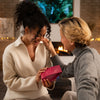Your skin type is completely natural and uniquely yours – it won’t change overnight, and it doesn’t need to.
However, daily life can bring unexpected challenges, from weather shifts to environmental changes, that affect how your skin looks and feels. That’s why we created the Glow Academy series: to help you understand your skin, identify what’s impacting it, and discover the best ways to achieve a healthy, glowing complexion, every day.
Today, we're diving into all things dry skin –what it is, why it happens, and how to nourish and care for it effectively.
What Is Dry Skin?
Let’s start by breaking down the difference between dry and dehydrated skin. Dry skin is a permanent skin type caused by a lack of natural lipids (fats and oils). Meanwhile, dehydrated skin is a temporary condition caused by external factors that reduce water in the skin’s upper layers. Anyone can experience dehydrated skin, no matter their skin type.
Now that’s cleared up, let’s discuss dry skin in more detail. It all starts with the skin’s moisture barrier – a layer of fats in the epidermis that locks in moisture and natural oils (sebum) to keep skin nourished and plump. People with a genetic predisposition to dry skin often have a weaker barrier function, making it easier for moisture and sebum to escape. The result? Skin that appears rough and flaky, and feels irritated and tight.
As well as being a skin type, dry skin is also a frequent symptom of conditions like eczema or psoriasis. If you’re noticing frequently occurring dry patches that are very itchy, you should always speak with a doctor or dermatologist.

What Factors Impact Dry Skin?
As winter sets in and temperatures drop, dry skin often becomes more noticeable. Central heating may keep us warm, but it also strips moisture from the air—and our skin. Outdoors, icy winds and rain can irritate and redden skin, and moving between these environments leaves dry skin feeling tight and aggravated.
While a warm bubble bath might seem like the perfect fix, hot water isn’t always dry skin-friendly. Frequent baths or long soaks can strip skin of its natural oils, leading to further dryness – hence those pruney fingers after a long soak or washing the dishes.
Dry skin is also more common as we age. Reduced sebum production, hormone changes during menopause, cumulative sun exposure, and slower cell renewal can all contribute to skin feeling drier over time.
How Do I Care For My Dry Skin?
Gentle Cleansing
Keep bathtime as a once-a-week indulgence, opt for quick power showers and always wear gloves when washing up.
Use warm, moderate water – think tropical ocean, not steaming spa – and when you’re done, gently pat your skin dry with a towel to lock in moisture.
For a skin-friendly cleanse, try our pH-balanced Luxury Bath Foams, Body Washes, or Signature Hand Wash. Formulated with gentle coconut cleansers and nourishing botanical oils, they support your skin’s barrier while avoiding irritation.
Make Time To Moisturise
Moisturising is essential for dry skin – but choose one that specifically works to calm, comfort and repair your skin barrier, like our Skin Re-Leaf Soothing Moisturiser.
Once you’ve moisturised your face, don’t neglect your body. Find a nourishing body cream you love and apply it all over immediately after towel-drying post-shower. Focus on typically dry areas for extra hydration and protection.
Use Central Heating Wisely
While central heating keeps you cosy, it can play havoc with your skin. Use a humidifier to add moisture back into the air and keep your skin hydrated.
Check Ingredients Lists
Dry skin is typically very prone to irritation, so be as cautious with the ingredients in your skincare as possible. It’s sensible to avoid products containing alcohol, fragrances or additives, and if you want to use a face mask, choose one that’s hydration-focused, like our Comfort Food Deep Hydration Mask.

Which Ingredients Are Good For Dry Skin?
Hyaluronic Acid
A hydration powerhouse, hyaluronic acid attracts water to the skin and helps retain moisture in its deeper layers, to keep it hydrated, plump, and comfortable.
Ceramides
These natural fats are the building blocks of your skin’s moisture barrier. They strengthen and repair the barrier, while helping to lock in hydration and protect against environmental stressors.
Squalane
This deeply nourishing emollient mimics your skin’s natural oils, preventing moisture loss and softening dry patches. It’s a game-changer long-lasting hydration and smooth, supple, and balanced skin.
The dry skin FAQ
Why is my skin dry even when I moisturise?
There’s could be a myriad of factors at play here, so let’s break them down one by one:
- If you want the best possible results from your moisturiser, consistency is key. Apply every morning and night so that your skin naturally falls into rhythm with it.
- Skimping on exfoliation? If moisturiser is just being slathered over built-up layers of dead skin cells, it won’t be able to do its job and properly penetrate into the epidermis’ upper layers.
- As somebody with dry skin, you opt for a richer moisturiser that will really nourish your complexion with heavier hydration.
- Patting moisturiser into skin, or massage in very small circles, to maximise absorption.
What foods can affect dry skin?
Alcohol (we know, technically not food) and foods high in salt can really have a negative impact, as they both dehydrate cells and exacerbate the effects of dry skin.
Instead, look to add foods like vitamin C-rich cucumber and health-packed avocado into your diet. Plus...you guessed it, water! And lots of it – you want to aim for seven to eight glasses a day.

 Skincare
Skincare
 Sale
Sale
 Bestsellers
Bestsellers
 Makeup
Makeup
 Body Care
Body Care
 Men's
Men's
 Hair Care
Hair Care
 Mama & Baby
Mama & Baby








